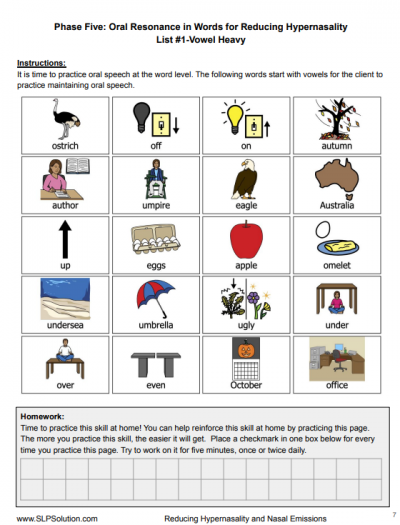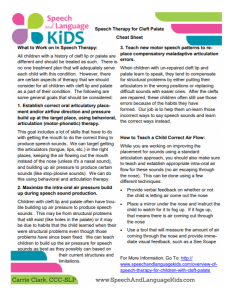What is Nasal Emission?
Nasal emission is a type of speech error where air is forced through the nose while producing sounds that don’t normally require nasal air flow. When we say words with the /m/, /n/, or “ng” sounds, air comes through our nose. If a word does not contain those sounds, air is not supposed to flow through the nose.
Nasal emission may sound like snorting or like there is a rattling sound in the nose. You also may notice a blowing sound through the nose. The term “hypernasality” is also used to describe too much air flow going through the nose.
What are the Types of Nasal Emission?
There are two types of nasal emission: learned and obligatory.
- Obligatory Nasal Emission: Air flow is forced through the nose due to structural problems that make it difficult or impossible for the person to block off the nasal passages. This may happen if someone has a cleft palate, a fistula (hole) in the palate, or their if their soft palate is too short or doesn’t work properly.
- Learned Nasal Emission: Learned nasal emission occurs when the oral structures and functions are adequate but the person has learned to produce the sounds with incorrect air flow anyway. This may just be a quirk of how a child learned to say a specific sound. Or, it may be because a physical problem was present before when the child was learning to say those sounds, even though it has since been fixed. This can be the case with repaired cleft palates.
What is Phoneme-Specific Nasal Emission?
Phoneme-Specific Nasal Emission is when nasal emission occurs on one or more specific sounds. This is often seen on fricatives (like /s/, /z/, /f/, /v) and affricates (“ch”, “sh”). When no structural problems are found, this can be treated through speech therapy.
What is an Active Nasal Fricative?
Active nasal fricative is another term for nasal emission on fricative sounds. In this type of speech error, air is forced through the nose when saying oral fricatives (like /s/, /z/, /f/, /v/), generating turbulent airflow in the nose instead of making the fricative sound in the mouth. Active nasal fricatives can be due to a structural problem in the mouth. Or, they can simply be the result of the child learning to say the sounds incorrectly when he/she was younger. Speech therapy can help for children with active nasal fricatives.
Source: Kjellmer 2021
Refer to ENT
When nasal emission is found, a referral should be made to an ENT or a regional craniofacial or cleft palate team (even if there is no history of cleft) for further assessment and management.
Who is Appropriate for Speech Therapy After ENT Clearance:
- Phoneme-specific nasality or nasal emission due to faulty articulation
- Children who use compensatory articulation productions due to a history of velopharyngeal dysfunction
- After surgical management of velopharyngeal dysfunction to help the child to learn to make the best use of the new structures
Source: Kjellmer 2021
How to Do Nasal Emission Speech Therapy:
Non-Speech Oral Motor Exercises for Nasal Emission Speech Therapy:
ASHA advises against use of non-speech oral motor exercises like blowing and sucking for improving velopharyngeal function. The parts of the brain that control blowing and sucking are not the same as those that control speech production so benefits will not carry over to speech.
Strategies for Nasal Emission Speech Therapy:

- If there is nasal emission on sibilants only, have the child produce a /t/ sound with the teeth closed. Next, have the child prolong that sound. If the child has a normal velopharyngeal valve, this should result in a normal /s/ without nasal emission. This skill can then be transferred to the other sibilant sounds.
- If the child co-articulates /ng/ for /l/ or /r/, or if the child has a high tongue position for vowels, it is often helpful to have the child co-articulate a yawn with the sounds. With a yawn, the back of the tongue goes down and the velum goes up.
What if it’s Not Working?
If the child continues to demonstrate hypernasality or nasal emission after a few months of treatment, that child should be referred to a specialist for further assessment and consideration of physical management.
Source: Kummer 2006

About the Author: Carrie Clark, MA CCC-SLP
Hi, I’m Carrie! I’m a speech-language pathologist from Columbia, Missouri, USA. I’ve worked with children and teenagers of all ages in schools, preschools, and even my own private practice. I love digging through the research on speech and language topics and breaking it down into step-by-step plans for my followers.
Fun Fact: I just asked my 9-year-old to tell me a fun fact to add to this page. He said, “you’re a really good mom! I hope they like that fact!”.
Connect with Me:





Hi
I am working with a child who has nasal emission on sh, ch and dg only? No nasal emission on the s
Do you have any suggestions on where to start.
I would probably try starting with the /s/ and see if they could transition from that to the sh without losing the oral airflow
I have the other problem. No nasal emission on any sound except /s/ and /z/. Cannot make /s/ without nasal emission.
I suggest that you seek help from a speech-language pathologist near you who can evaluate your specific problem and determine what the best course of action is.
I have a child that has nasal air emission on s (lateralized), z, ch, sh, d3. any tips !??
Did you find an answer to your question. My student seems very similar,
Hi! Thanks for these tips they are great! I have a kiddo who’s /l/ sounds like /ng/, how common is this? does is suggest that he should get a further eval to rule out anything serious? any other tips or tricks besides the yawn for proper placement?
It’s hard for me to say what needs further evaluation without seeing it myself. Generally, I say that if you try some therapy for 4-6 weeks and don’t see any improvement, it’s always good to get a more thorough eval to make sure
I am working with a child who has significant nasal emissions with the /k/ and /g/ sounds. He had his adenoids removed at age 3 (he’s now 6), has a high arched hard palate, and his uvula is very far back- it’s difficult to see and is actually attached to his left tonsil it appears. Not bifid though. Do you think I should try some attic therapy first, before referring to an OMF team? Thank you.
Since I haven’t worked with the child in question, I cannot say what would be best for him specifically. However, in the absence of any major issues or physical concerns, 6 weeks of therapy should give you a good idea of if a child will make progress without further evaluation.
Please Guide me, I want to know about the real reasons for the NASAL SOUNDS.Can it be cured with some therapy or there is any other treatment in medicament like Surgery.
Trouble with nasal sounds can be helped with speech therapy!
I have a student who produces /n/ for /l/. When her nose is held closed, it sounds correct /l/. When you leave her nose open, it comes out as /n/. Her tongue and lip placement is intact. Have you heard of anything else to try aside from the yawn method?
I’m not sure what to do about that one! My only thought would be to try working on helping the child hear the difference between the two sounds (with the nose plugged and unplugged) and see if she could hear the difference and feel the difference enough to eventually be able to produce them differently. That’s just a thought though, no idea if it would help!
I have same issue
Is there any cure?
I have a student that has nasal emission only on /r/. I have used a see scape to no avail. I have also tried starting with the ah sound and moving into raising the tip of the tongue to the hard palate and he is unable to produce it without nasality. I’m thinking of recommending he be seen by an ENT just to make sure nothing structural is causing it. What are your thoughts?
Generally speaking, if you’ve been doing therapy for about 6 weeks and haven’t seen improvement, it’s always a good idea to get the physical structures checked out, just in case!
I have a 6 year old boy who has received speech therapy since preschool specific to the /r/ production. The previous therapist indicated that he was making great progress and may be dismissed from services in kindergarten. She also mentioned that he had used abnormal mouth posture while practicing this sound for a brief period of time. When therapy was initiated in kindergarten he began producing a nasal /r/. We worked on achieving accurate tongue placement, which he was occasionally able to achieve. A few weeks ago, his parent emailed and asked what I was doing different in therapy, were there new sounds we were working on, because she can’t understand a thing he says. After receiving her email, I pulled him out from class to listen to his speech, since I had just seen him earlier that week and had not noticed any additional nasality on other speech sounds or difficulty understanding his spontaneous speech. When I listened to him, I was completely taken back by how his speech had changed so drastically over just a period of three days. The nasal emission had generalized to other speech sounds such as ‘f, s, z, sh, ch, j, l’ and significantly impacted his intelligibility. I had made a video of his spontaneous conversation, which I had another Speech Therapist view. She recommended that he be referred to the school nurse. After the nurse had an opportunity to meet with him, she called his mother and recommended that she take the boy to the doctor. The boy’s Pediatrician felt it was related to allergies and told mom to put him on over -the -counter allergy medication. He has been on the medication for approximately 12 days with minimal change in the degree of his nasal emission. His annual IEP comes due soon, which will now reflect reducing nasal emission, but I am still concerned about the ‘why’ of how quickly the nasality generalized to other speech sounds which he ihad no difficulty with and is able to produce without nasality in isolation and at the syllable level. This occurs I words containing these sounds that do not include the /r/. Do you have any thoughts and recommendations regarding this?
Hey there! Unfortunately, our licensing board says that we are not allowed to “treat via correspondence”, which basically means that since I haven’t worked with your child directly, I can’t state my opinion on what’s going on with him. A speech-language pathologist who can work with him directly may be able to help! Sorry!!
Hi, I am late to the conversation but I have an almost identical case that I am trying to figure out. Whatever came of this? Did you figure out the cause?
I just started working with a child with phoneme specific nasal emission on ch, sh, and “j”. I tried to have him transition from an /s/ to a sh but as soon as he switches the nasal emission starts again. Any suggestions? I had him prolong the /s/ but still no change.
That can be so tricky. Since I haven’t worked with the child directly, I don’t have any specific strategies to recommend. But I can say that sometimes it takes a while for these strategies to work. Sometimes you have to keep working on the sounds in isolation for a few weeks before the student starts to get it. Though, if the child has been working on that specific skill for 6 weeks or more with no progress, an evaluation by an ENT may be in order.
Hi, thanks for this info. My son has hyponasal speech with s and z sounds only. He has been through four rounds of speech therapy over the past year (unfortunately with four different speech therapists). Progress was very slow, and, at some point, a speech therapist noted that he also had problems with sh and ch sounds. I could be wrong, but I think that this developed over the course of therapy – maybe because he was concentrating so hard on s and z. By the end of his last therapy session, his speech therapist thought his speech was mostly good and he was fine to stop therapy and just practice at home. Two months later and his speech is terrible again. He needs constant reminders and when he tries to correct the same sounds, he messes up other things. Is it normal for this to take so long to resolve? Is it possible that there is something structural going on even though it is only certain sounds? He was referred to a vpi clinic and they refused to do a scope – I think because it is only certain sounds and he can make a good s sounds when he really concentrates.
Sorry, I meant hypernasal speech.
Does anyone know how to transcribe in a way that denotes nasal air emission? My student has NAE on /s/.
Hi, Karen-
Have you reviewed this link: https://www.speechandlanguagekids.com/how-to-treat-nasal-emission-in-speech-therapy/?
Hi, thanks for the tips! I have a 5yo patient with nasal emissions on all stridents /f, v, s, z, ʃ, ʒ, tʃ, dʒ/, except sometimes he stops /v/ with or without co-occuring emissions (I’m guessing to compensate for air out of his nose). He produces tʃ & dʒ in the initial position of words and he also produced “lunch” correctly today. I tried having him imitate “munch” to see if the /n/ facilitated this for him but it did not work. We tried plugging the nose today but he could not seem to get any sounds out of his mouth, even at a whisper, air was being forced to his nose which caused him discomfort. I already sent him to ENT and the ENT basically just did another oral mech exam, stating that the soft palate seemed slightly high and short. Any other interpretations or therapy recommendations? I have only seen him once but will try the t->s strategy next week.
Hi
I have a student who has nasal emission and it is extremely difficult to understand her. Her sister is pretty much the same. She went to ENT appointment and then was referred to an SLP for further evaluation. She watched her sister go through some testing and then refused to do it after watching her sister scream and cry. I have set up 3 different appointments and have an interpreter to help her mom at the appointment. Mom has not gone to any of the appointments. She keeps saying she will and then does not follow through. I really don’t know what to do at this point. She is in 4th grade in a self contained classroom and just struggles with everything. I want to help her and just don’t know what else to do. Do you have any ideas?
Hi. I am SLP and working with nasal emission on sibilants. Have achieved proficiency at sound level using the /t/ behind teeth but unable to move onto CV level. Any tips?? The child reverts back to emission when combining with a vowel
Hi,
I have a student that has nasal air emission on /s, sh, z, j, ch, and t/. I thought he may demonstrate PSNE, but then I’ve been noticing that the /t/ he also demonstrates nasal air emission on too. I’ve tried the nose plug strategy and he absolutely hates it and always says that it feels uncomfortable. I’ve tried focusing on placement only which made minimal progress. I’ve also tried to produce the /s/ from a /t/ sound, but with nasal air emission with the /t/ as well that hasn’t made much progress.
Any suggestions?
Thank you!
Hello, Chelsea – Thank you so much for reaching out. Unfortunately, we get a ton of questions every day about how to solve specific speech/language problems. Since we have such a small staff, we aren’t able to answer every question that comes through on the website, social media, or via email. If you are a parent, we suggest you reach out to a local speech-language pathologist who can work with your child directly and answer your question.
If you are another speech-language professional, we have created a membership where we pay a full staff to answer questions like this on a regular basis. We would be more than happy to answer your question inside the membership program. We’re able to answer more questions in here because we have a full library of questions that we’ve already answered so our staff can either link you to the answer if it exists, or write you a custom response if needed. We’d love to see you inside the membership!
Click Here to Become a Member: https://www.slpsolution.com/pediatric-signup/
I have a child who recently had a submucus cleft repair. However, she is still extremely difficult to understand due to nasal emission. I would say that she has nasal emission on just about every sound.
Hi, I had a history of bilateral cleft lip & palate, but recently I had a full check up & my surgeon suggested that I don’t need any further surgeries, my plate is complete 7 nose-lip revision is also completed, but I still have speech I still have Nasal emission in my speech & also I’m unable to produce[z] sounds. I’m 25 years of age. with consistent therapy will I be able to fix my Speech problems? I’m doing Self-therapy.
Hey there! Since I haven’t worked with you directly, I can’t say what therapy should or will look like for you. My best advice would be to speak with a speech-language pathologist who can work with you directly and make specific recommendations. Even if you’re interested in doing self therapy, you could work with them for a few sessions to get the right recommendations and then ask them to create a home program for you. There are many different approaches that may need to be used depending on your current situation and trying to figure that out on your own might be tough! I hope you can find someone that you trust who can help you out in person!
Hi Carrie!
I have a student I’m currently assessing for apraxia of speech. He just had his adenoids out two months ago. Wouldn’t the ENT notice anything structurally wrong or not? I guess the child need to be awake to be able to see functional issues? Do ENT’s check that when they remove adenoids and/or tonsils? Just curious.
Hey there! I would guess that they would probably notice anything super obvious but wouldn’t catch something little. You could still do a quick oral mechanism exam just to make sure you don’t catch anything they missed!
Hi! I have a student who is on year two of speech therapy (my first year with him though), and he has a lot of nasal air emission (most noticeable on fricatives and affricates). His last SLP made an ENT referral, as did I, and he finally just went in earlier this month. They wrote, “I asked the patient to repeat the words ‘kick,’ ‘baseball,’ and ‘puppy puppy puppy’ and I did not hear nasal escape. He has mobility of his tongue beyond the lower and upper lip. Because he is able to produce /k/, /b/, and /p/ sound without nasal escape, his soft palate is able to physically occlude his oropharynx. The fact that it does not do so at times with certain letters suggests more of a neuromuscular control issue rather than incompetence of his soft palate. I do not think a procedure such as a pharyngeal flap is indicated. I recommend continued speech therapy.” I was very surprised to read this, as it really seems like something structural is causing his speech difficulties. Thoughts??
Oh man that’s a tough one. Without having worked with the child directly I cannot give you specifics for him. However, I can tell you a bit more about phoneme-specific nasal emission. I had ChatGPT help me comb through the research on the current literature to see what we could come up with. I have edited the response below:
Phoneme-specific nasal emission (PSNE), where nasal airflow occurs exclusively during the production of certain sounds—commonly sibilant fricatives and affricates like /s/, /z/, /ʃ/, /tʃ/, and /dʒ/—is typically attributed to velopharyngeal mislearning rather than structural abnormalities or neuromuscular deficits. This mislearning involves the use of atypical articulatory placements, such as pharyngeal or posterior nasal fricatives, leading to inappropriate nasal airflow during these specific phonemes.
The fact that an individual can produce plosive sounds (e.g., /p/, /b/, /t/, /d/, /k/, /g/) without nasal emission suggests that the velopharyngeal mechanism can achieve proper closure. This selective occurrence of nasal emission indicates that the issue is not due to structural problems, such as velopharyngeal insufficiency (VPI), but rather to learned misarticulations affecting specific sounds.
In cases of PSNE, speech therapy focusing on correcting the misarticulated sounds is the recommended approach. Techniques may include teaching correct tongue placement and airflow direction to eliminate the inappropriate nasal airflow during the targeted phonemes.
In summary, when nasal emission is phoneme-specific and absent during plosive production, it is generally considered a result of velopharyngeal mislearning rather than structural or neuromuscular causes.
Does this help?
Hi Carrie,
I have a pupil in my setting that has nasal emission on just the //s// sound which I think it is the sensation that they are liking as when we do the long tttts sound they are able to say //s// sound with ease. Would you agree that this is for the sensation that they are using the nasal sound rather than a speech problem.
Or could you suggest any other activities that may be useful.
That’s a tricky one! I can’t say for sure what’s going on with a child that I haven’t worked with but it’s definitely possible that the child is getting some sort of sensory input from it. These same therapy strategies of increasing awareness and teaching proper placement and airflow should work regardless.